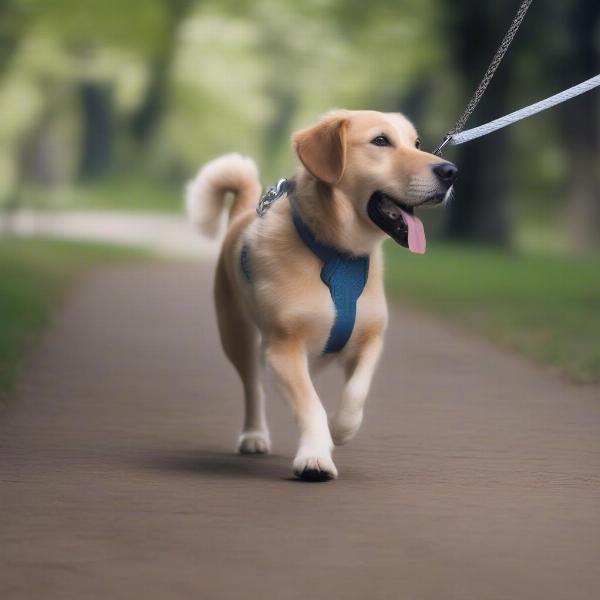Dog head collars, also known as head halters, are a training tool designed to gently control a dog’s head and, consequently, their body. They offer an alternative to traditional collars and harnesses, particularly for dogs who pull on the leash or exhibit other unwanted behaviors during walks. Understanding how these collars work, their benefits, and how to use them correctly is key to ensuring a positive experience for both you and your canine companion.
Understanding How Dog Head Collars Work
Unlike traditional collars that attach to the neck, dog head collars fit around the dog’s muzzle and behind the ears. When a dog pulls forward, the collar gently turns their head, redirecting their attention and preventing them from straining against the leash. This mechanism mimics the way mother dogs correct their pups, making it a humane and effective way to manage pulling and improve leash manners. They are particularly helpful for strong, energetic dogs who can be difficult to control with traditional collars.
Benefits of Using a Dog Head Collar
 Benefits of Using Dog Head Collars for Training and Walking
Benefits of Using Dog Head Collars for Training and Walking
Dog head collars offer several advantages, especially for dogs who are prone to pulling or have reactivity issues:
- Reduced Pulling: By controlling the head, these collars effectively minimize pulling, making walks more enjoyable for both dog and owner.
- Improved Focus: The gentle redirection helps dogs focus on their handler and reduces distractions.
- Enhanced Safety: Greater control over the dog’s movements translates to increased safety in various situations.
- Gentle Correction: The head collar’s design provides a gentle yet effective correction without causing discomfort or pain. dog head collars
Choosing the Right Dog Head Collar
Selecting the appropriate dog head collar is crucial for comfort and effectiveness. Consider your dog’s breed, size, and muzzle shape. Measure your dog’s muzzle circumference and refer to the manufacturer’s sizing chart for the best fit. halter dog head collar There are several reputable brands available, including the Gentle Leader and the Halti, each with slightly different designs. Researching and comparing these options can help you find the ideal fit for your dog.
Introducing Your Dog to the Head Collar
Introducing the head collar gradually and positively is essential. Start by letting your dog sniff and investigate the collar. Associate it with positive experiences by pairing it with treats and praise. head collar dog Gradually introduce the collar onto their muzzle, starting with short periods and slowly increasing the duration. Make sure the collar fits snugly but not too tight. Never force the collar onto your dog.
Training with a Dog Head Collar
Once your dog is comfortable wearing the head collar, begin leash training. Keep the leash loose and reward calm, controlled walking. Avoid jerking or pulling on the leash, as this can create negative associations. dog halti head collar Use positive reinforcement techniques, such as treats and verbal praise, to encourage desired behaviors. Consistency and patience are key to successful training with a dog head collar.
Conclusion
Dog head collars can be a valuable tool for managing pulling, improving focus, and enhancing safety during walks. By understanding how these collars work, choosing the right fit, and implementing proper training techniques, you can help your dog become a more well-behaved and enjoyable walking companion. Remember that patience and positive reinforcement are essential for successful head collar training.
FAQ
- Are dog head collars cruel? No, when used correctly, dog head collars are not cruel. They provide gentle guidance and control without causing pain or discomfort.
- Can my dog eat or drink with a head collar on? Some dogs can eat and drink with a head collar on, while others may require it to be removed temporarily.
- How do I know if the head collar fits correctly? The collar should fit snugly but not too tight. You should be able to fit two fingers comfortably between the collar and your dog’s skin.
- How long does it take to train a dog with a head collar? The training duration varies depending on the dog’s individual temperament and learning pace.
- Are dog head collars suitable for all breeds? While generally safe for most breeds, consult with a veterinarian or professional dog trainer for specific breed recommendations, particularly for brachycephalic breeds.
- Can I leave the head collar on my dog unsupervised? No, head collars should only be used under supervision.
- What if my dog continues to pull even with the head collar? Consult a certified dog trainer for personalized guidance and training tips.
Related Articles
dog friendly hotels portsmouth uk
About ILM Dog
ILM Dog is your one-stop resource for expert advice on dog care and training. We cover a wide range of topics, from breed selection and health care to nutrition, grooming, and training tips. Our goal is to empower dog owners with the knowledge and resources they need to provide the best possible care for their furry companions. Whether you’re a seasoned dog owner or just starting your journey, ILM Dog offers valuable insights into every aspect of dog ownership. Contact us at [email protected] or +44 20-3965-8624 for personalized advice.